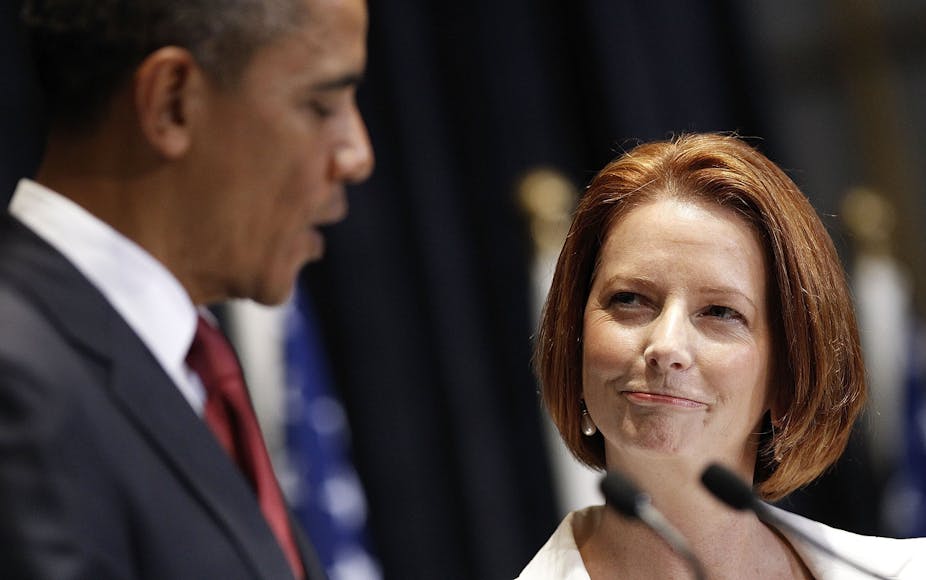President Barack Obama’s visit to Australia will continue to be filled with diplomatic niceties and weasel words: repeated declarations of fondness and friendship will point to “shared values”, the “special relationship” and “common cultural traditions”.
Alliances inevitably impose some kind of asking price on their members. Australia’s firm reliance on the US has mutual advantages and risks.
The rise of China
How to successfully maintain a durable and credible relationship while managing limited resources, multifaceted diplomatic demands and, at times, divergent interests, offers an enormous challenge for Australian decision-makers.
Core strategic questions will need to consider how the US is prepared to accommodate the rise of China, the motivations for shifts in course in Chinese diplomatic behaviour and whether US-China relations can avoid a detrimental, over-competitive liaison driven by mutual insecurities.
From an Australian perspective, rising tensions and the potential for conflict between the US and China represents a nightmare scenario. Any redistribution of US forces in the Asia pacific, including plans to boost the US-Australia defence relationship by allowing marines to “rotate” through Darwin, will need to proceed carefully. Australia cannot afford to send any type of signal that it might be part of wider containment policy to manage China.
Nonetheless, while China might remain the “dragon at the door”, President Obama’s visit to Australia is broadly focused on reinforcing the theme that that US interests are pivoting towards Asia.
US Secretary of State Hillary Clinton recently reaffirmed America’s long-term commitment to the region. She highlighted that “the world’s strategic and economic center of gravity is shifting east”.
Expansion of influence
Without doubt, both major parties in Australia do take very seriously the building of a strong alliance with the US. Australia’s logic, in part, has always been reinforced by a psychological dependency on “great and powerful” friends.
It’s presumed that being US-friendly will deter would-be aggressors. At the very least, growing ties have allowed Australia to promote and expand its influence further than its size might otherwise warrant. And there will be other tangible benefits too: intelligence-sharing, technology transfer and the adding of a strategic depth and mobility to current and future military operations.
But in the midst of such pleasant diplomatic back-slapping, it is also worth reflecting on another oft repeated diplomatic observation. In the 19th century British statesman, Lord Palmerston famously stated that there are no eternal allies or enemies, only eternal and perpetual interests.
When applied to the management of US-Australia relations, Palmerston’s notion warns of the dangers of an uncritical approach to US grand strategy and the inherent vulnerabilities in relations that are automatically taken for granted. It also suggests that while national interests may well intersect and have common ground, they will not always be mechanically and routinely identical.
This historical context can be extremely insightful. As Paul Dibb has identified, the events of 9/11 upended Australian defense planning – observers traditionally assumed that the ANZUS treaty would be about an US “security-blanket” helping Australia and providing protection for Australia’s prosperity. In the wake of the terrorist attacks, it appeared Australia was expected to assume extended strategic burdens and a wider array of precarious defense commitments.
Policy to preserve friendship
For the first time, the then Howard government invoked the ANZUS treaty – an open-ended pledge that led to the commitment of Australian troops in Afghanistan and Iraq.
Yet not only was the activisation of the treaty legally nonsensical but Howard himself later admitted that “alliance considerations” were a core factor in his decision. This despite the Bush White House foreign policy vision which was predominantly fixated on a desire to maintain US hegemony and maximise US autonomy at any cost.
Interestingly, the early formation of ANZUS itself was motivated by contradictory reactions to shared international security settings.
The US wanted the alliance primarily to take advantage of Australia’s geopolitical positioning in order to advance a global containment strategy to halt presumed Chinese aggression (and wider Soviet influence). High level talks were concerned with developing sophisticated global arrangements to counter specific global threats and resist the spread of communism.
On the other hand, Australian preoccupation had a much more introspective incentive. Security outlooks remained fixated about the possible revival of Japanese militarism. With fearful memories of the Japanese threat during World War Two, many Australian policymakers had been unsettled about what they viewed as a “soft” post-war peace treaty; a treaty that had taken insufficient precautions about Australia’s physical isolation combined with the revival of Japanese militarism.
Strategic position
So while Australia hoped to secure the US presence as a Pacific power as a potential shield against Japanese rearmament, Washington had already begun to cast (non-Communist) Japan as a mutual friend in the region.
Obama’s visit does signal that US-Australian ties will remain both an important and enduring component of Australia’s national security. Yet in order for ANZUS to remain a viable and sustainable partnership, there must be scope for disagreement about policy direction and policy-makers should not be afraid to voice a more autonomous line.
This might be particularly relevant if any current or future US administration becomes preoccupied with demonising the rise of China and views clashes between Washington and Beijing as inevitable.

